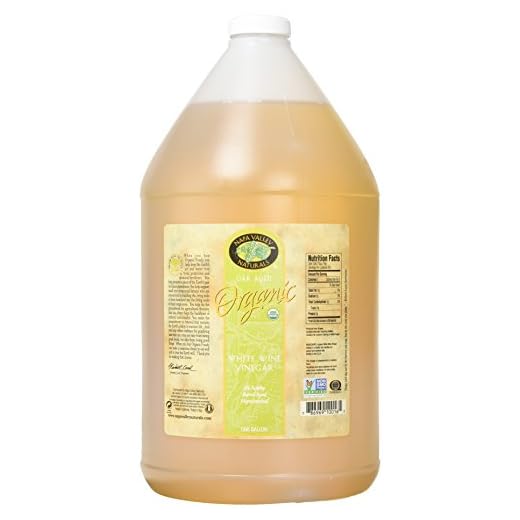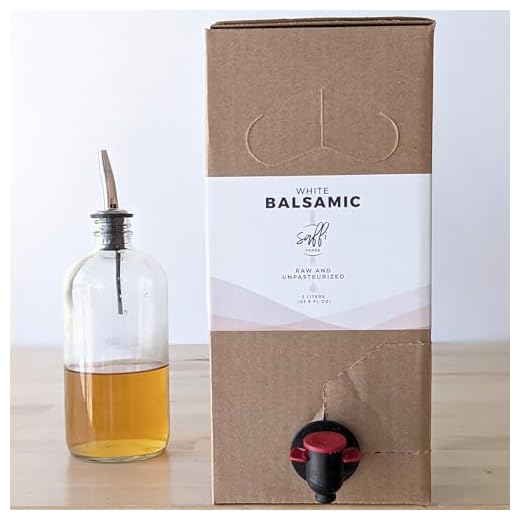

If you’re considering a substitution in your pantry, be aware that these two liquids serve different culinary purposes. The former is sharp and acidic, making it ideal for dressings, marinades, and cooking. In contrast, the latter offers a sweeter, milder profile, perfect for drizzling over salads or incorporating into glazes.
When selecting between them, think about the flavor you wish to achieve. For dishes that require a vibrant acidity, the first option is your go-to. On the other hand, if you’re looking to add a touch of sweetness and complexity, reach for the latter. Each brings its unique characteristics to the table, and understanding their differences can elevate your cooking.
In my experience, experimenting with these two can lead to delightful discoveries in flavor combinations. Always taste and adjust according to your palate; culinary creativity thrives on such explorations!
Is White Wine Vinegar the Same as White Balsamic Vinegar?
These two culinary liquids serve different purposes in the kitchen. The first is sharper and more acidic, making it perfect for salad dressings and marinades. In contrast, the latter offers a sweeter, milder taste, which complements dishes where a gentler acidity is preferred.
When substituting, consider the dish and desired flavor profile. If a recipe calls for one and you only have the other, balance the flavors by adjusting the quantity accordingly. For instance, if using the sweeter version in place of the sharper one, use less to avoid overpowering the other ingredients.
For effective kitchen cleaning, consider using the best cleaner to put in pressure washer to maintain your cooking space. Keeping your tools and surfaces clean will enhance your culinary experience.
Understanding the Production Process of White Wine Vinegar
To appreciate the nuances of this acidic condiment, it’s vital to grasp its production. The process begins with fermented grape juice, which undergoes a transformation through oxidation. Here’s a breakdown of the key stages involved:
- Fermentation: Fresh grape juice is fermented using specific strains of yeast. This step converts sugars into alcohol, forming the base liquid.
- Acetification: Once fermentation is complete, acetic acid bacteria are introduced. These microorganisms convert the alcohol into acetic acid, which gives the product its characteristic sour flavor.
- Aging: The resulting liquid is then aged in containers, typically made of wood or stainless steel. Aging allows for the development of complex flavors and aromas.
- Filtration: After aging, the liquid is filtered to remove any sediment or impurities, ensuring a clear final product.
- Bottling: Finally, the filtered liquid is bottled and sealed, ready for distribution and use in culinary applications.
Throughout this process, factors such as grape variety, fermentation duration, and aging conditions significantly influence the final flavor profile. Each producer may have unique techniques that contribute to the distinctiveness of their product.
Exploring the Ingredients in White Balsamic Vinegar
When selecting a high-quality product, focus on the primary ingredients: grape must and vinegar. The must is derived from freshly pressed grapes, which undergo a cooking process to concentrate their flavors and sweetness. This step is crucial, as it enhances the final product’s profile, resulting in a delicate balance between sweetness and acidity.
Another key element is the type of vinegar used. Traditionally, this variety employs a blend of wine vinegar, specifically from white grapes, which contributes to its distinct taste. The fermentation process transforms the sugars into acetic acid, creating a tangy flavor that complements a variety of dishes.
Quality Indicators
Look for products that list “grape must” as the first ingredient. This indicates a richer flavor and higher quality. Additionally, check for aging information; a longer aging process often results in a smoother, more complex product. Some brands may specify the aging period, which can enhance your culinary creations.
Flavor Profile
The unique combination of ingredients results in a sweet and tangy flavor, often with notes of fruit and subtle woodiness, depending on the aging process. This versatility makes it an excellent choice for dressings, marinades, or drizzling over dishes like grilled vegetables and salads. Pair it with lighter proteins or use it to add depth to sauces.
Tasting Notes: Flavor Differences Between the Two Vinegars
When comparing these two condiments, it’s essential to recognize their distinct flavor profiles. The first type offers a sharp acidity with a crisp, clean taste that often highlights notes of apple and citrus. It tends to be more straightforward, making it an excellent choice for dressings and marinades where you want brightness without overwhelming other flavors.
In contrast, the second variety presents a milder, sweeter essence, characterized by a complex balance of acidity and sweetness. Its flavor can include hints of stone fruits and a slight caramel undertone, thanks to the aging process. This richness makes it particularly well-suited for drizzling over salads, grilled vegetables, or even desserts, enhancing the overall taste experience.
For those exploring culinary applications, consider using the first option in recipes that require a punchy acidity to cut through fats, such as creamy dressings or rich sauces. The second version, with its smoother profile, works beautifully in glazes or reductions, where the goal is to create depth and add a touch of sweetness.
In tasting, be mindful of the intensity and complexity each brings to a dish. The first type is often more versatile for everyday cooking, while the second can elevate a meal with its nuanced flavors. Understanding these differences allows you to make informed choices in your culinary endeavors.
Cooking Uses: When to Choose White Wine vs. White Balsamic Vinegar
For dressings and marinades, opt for the first option when you desire a sharp acidity that complements greens and proteins without overwhelming the dish. This version excels in vinaigrettes, where its crispness shines through.
If you’re preparing glazes or reductions, consider the latter option for its sweeter profile and thicker consistency. It adds a touch of elegance to roasted vegetables or meats, enhancing their natural flavors.
When crafting sauces, the first variant works effectively in deglazing pans, providing a clean, bright flavor that lifts the dish. In contrast, the second choice can enrich creamy sauces, offering a hint of sweetness that balances savory elements.
For pickling, the first is preferable due to its acidity, which effectively preserves ingredients while maintaining their color and texture. The latter can be used sparingly in pickling to introduce a unique sweetness but should be balanced carefully.
| Usage | Best Choice |
|---|---|
| Dressings and Marinades | White Wine |
| Glazes and Reductions | White Balsamic |
| Sauces | White Wine |
| Creamy Sauces | White Balsamic |
| Pickling | White Wine |
In desserts, the latter variant can provide a delightful twist, particularly in fruit salads or sorbets, where its sweetness complements the natural sugars of the fruit. The first is less common in sweets but can be utilized in savory-sweet combinations.
Storage and Shelf Life Comparisons
For optimal preservation, keep both varieties in a cool, dark place, preferably in a sealed container. The acidity in these liquids helps inhibit bacterial growth, allowing for extended usability.
Typically, the lifespan of an opened bottle of each is similar, ranging from 3 to 5 years. However, the sealed versions can last much longer, often exceeding 10 years when stored correctly. Check for any changes in color or aroma, as these are indicators of potential spoilage.
Once opened, ensure that caps are tightly sealed after each use to minimize exposure to air. This will significantly prolong freshness and flavor integrity.
While both can remain usable beyond their prime, their flavor profiles may evolve, impacting culinary applications. For instance, older versions might have a more pronounced acidity or altered sweetness, which can affect dishes.
In summary, both types of these flavorful liquids require similar care to maintain quality. Regular checks for any off-putting characteristics will help ensure they remain suitable for culinary use.
Health Benefits: Nutritional Profiles of Both Vinegars
Both types of acidic liquids offer unique health benefits, each with distinct nutritional profiles. The clearer variety generally contains fewer calories and carbohydrates, making it a lighter option for those monitoring their intake. It typically has about 3 calories per tablespoon, with minimal sugar content, making it suitable for low-calorie diets.
In contrast, the darker version is slightly richer in calories, averaging around 14 calories per tablespoon. This variation contains natural sugars derived from the grape must used in its production, which contributes to its sweeter taste. Despite this, it remains a low-calorie option compared to many dressings and condiments.
Antioxidant Properties
Both liquids possess antioxidant properties, primarily due to the presence of polyphenols. The darker variant, due to its grape base, often has higher concentrations of these beneficial compounds, which can help combat oxidative stress and inflammation in the body. This can support overall health and may reduce the risk of chronic diseases.
Digestive Health
Each of these acidic liquids can aid digestion. The clearer version has been associated with improved gut health due to its acetic acid content, which may enhance the absorption of certain nutrients and support healthy digestion. The sweeter variant may also promote digestive health but in a different way, as its natural sugars can provide a quick energy source for beneficial gut bacteria.
Incorporating either option into your diet can enhance flavor while supporting health goals. Choose based on your nutritional needs and flavor preferences for optimal benefits.








